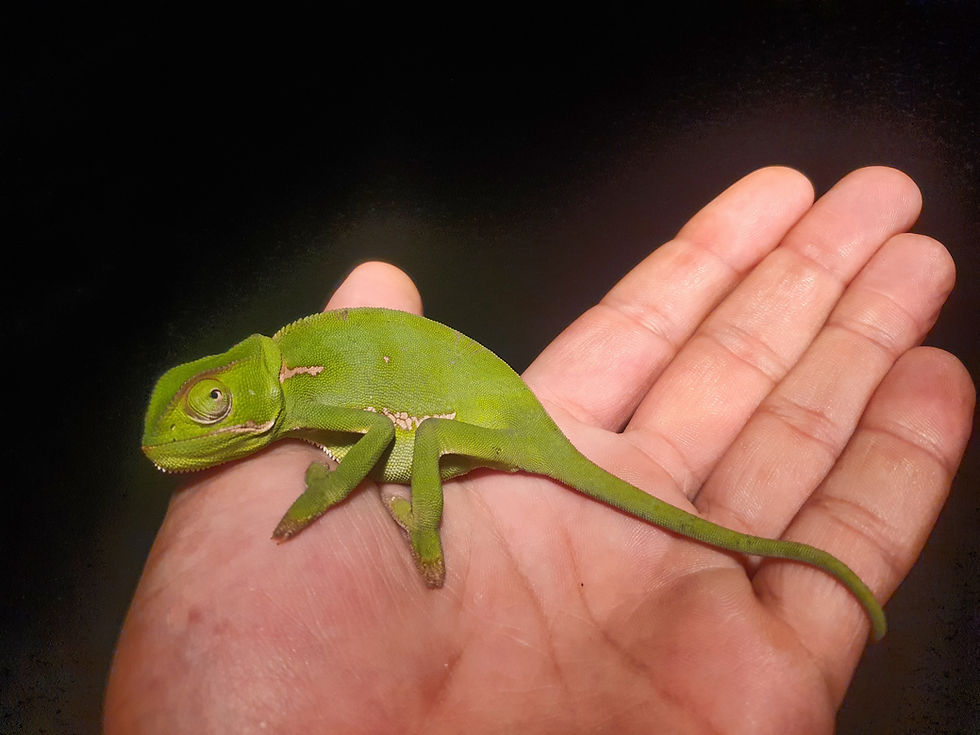Exploring the Flap - Necked Chameleon
In the heart of sub - Saharan Africa, there lurks a creature as enigmatic as it is captivating - the Flap - Necked Chameleon (Chamaeleo dilepis).
This arboreal marvel, a member of the Chamaeleonidae family, is more than just a reptile; it's a living, breathing kaleidoscope of nature's ingenuity.

A Tapestry of Subspecies and Names
This Chameleon isn't just one entity; it's a tapestry of eight recognized subspecies, each with its unique story. Take, for instance, the subspecies named "roperi", honoring G.D. Trevor - Roper, or "ruspolii", a nod to the Italian explorer Prince Eugenio Ruspoli.
These names aren't just labels; they're tributes to individuals who have contributed to our understanding of these fascinating creatures.
A Palette of Colors and Sizes
Imagine a creature that can reach up to 35 cm in length, adorned in a spectrum of greens, yellows, and browns. This isn't just any Chameleon; it's the Flap - Necked Chameleon.
Its coloration, complete with pale stripes and patches, is not merely for beauty; it's a survival strategy, blending perfectly into its surroundings.
An African Odyssey
The geographic range of Chamaeleo dilepis is as vast as the African continent itself. From the northern reaches of Ethiopia and Somalia to the southern tips of South Africa, this Chameleon makes its home in a variety of habitats.
Whether it's the coastal forests, savannas, or even suburban areas, it adapts and thrives.

A Circle of Life
The life of a Flap - Necked Chameleon is one of constant survival and adaptation. Females lay 10 - 40 eggs, embarking on a 10 – 12 - month journey before hatching.
Their diet is as varied as their habitat, ranging from invertebrates to occasionally other small reptiles. Yet, they too are part of the food chain, often preyed upon by snakes like the Boomslang and Twig Snake, bit aslso by birds like the African Cuckoo Hawk.
In Captivity
In captivity, Chamaeleo dilepis shows remarkable adaptability. Their enclosure must mimic their natural habitat, with a diet of Crickets, Mealworms, and other insects.
Their lifespan of 5 – 8 years in such environments is a testament to their resilience.
Conservation
Despite its popularity in the international pet trade, the Flap - Necked Chameleon's population remains stable. However, with over 111,000 individuals exported mainly to the USA between 1977 and 2011, conservationists urge for more in - depth studies to ensure their continued survival.

The Flap - Neck Feature and Color Dynamics
One of the most distinctive features of the Flap - Necked Chameleon is its namesake: the occipital flap.
When agitated, this flap rises, creating an illusion of increased size. Their color - changing ability is not just for show; it's a critical survival tool, helping them regulate body temperature and express emotions.
A Peek into Their World
Finding a Flap - Neck Chameleon in the wild is a treat for any nature enthusiast. Their mottled green camouflage makes them masters of disguise, turning a night game drive into an exciting quest.
Their hunting technique, using long sticky tongues, is as fascinating as their independent eye movements.
Five Fun Facts to Remember
Preference for Weak Branches: Contrary to what one might expect, Flap - Neck Chameleons favor weaker branches, a clever strategy to evade heavier predators.
Camouflage Mastery: The flap on their neck isn't just for show; it's a critical component of their camouflage.
Mottled Greens: Their body color mirrors the green hues of their arboreal homes.
Imitating Nature: They move with staggered motions, imitating the rustling leaves in the breeze.
“Dwarf Lion”: Their name translates to this, fitting for their aggressive and defensive demeanor.

Conclusion
The Flap - Necked Chameleon is not just another reptile; it's a symbol of nature's endless creativity and adaptability. As we continue to explore and understand these creatures, we uncover more about our own connection with the natural world.
So, the next time you're out on a safari or a night drive, keep an eye out for these little “dwarf lions” of the tree world – a glimpse into the intricate tapestry of life that thrives in the wilds of Africa.
About The Author
Kyle Grobler is a passionate environmentalist and esteemed field guide from Potchefstroom. With an unparalleled love for nature, he boasts a vast collection of over 40,000 photos, illustrating his particular affinity for birds.
Known by many as the embodiment of a true bushman, Kyle has ventured through various South African game reserves and frequently explores the Vaal River's hidden treasures. As a new contributor to the Potch Gazette's environmental page, readers can anticipate immersive tales of Potchefstroom's natural wonders through Kyle's expert lens.
To see more from Kyle and his bush experiences you can also view his Youtube Channel here: Kyle Grobler Photography
More Reptile Stories
For more articles about reptiles you can click on the links below, there are so many great reptiles living amoungst us to discover and learn about as they play a major role in nature as we see it today.
World Reptile Day 2023: Click Here
African Rock Python and Impala: Click Here
Monitor Lizards: Click Here
Leopard Tortoise: Click Here
Blue Headed Tree Agama: Click Here
Puffadder: Click Here
Serrated Hinged Terrapin: Click Here
Brown House Snake: Click Here
Spotted Bush Snake: Click Here
Setaro's Dwarf Chameleon: Click Here
Comments, Suggestions, Stories
Please do feel free to add any comments in our comments section below, we always love to hear about animals and experiences from our readers.



.jpeg)
